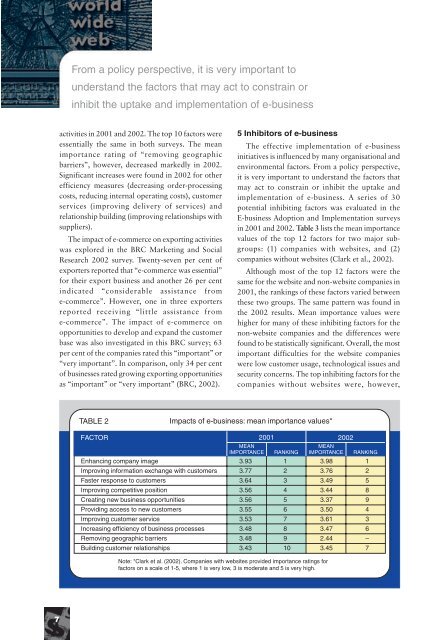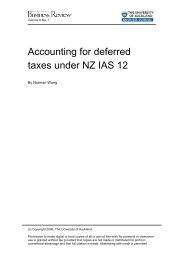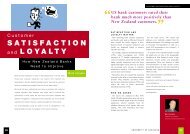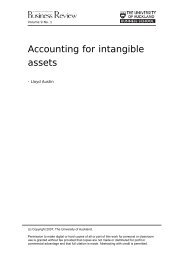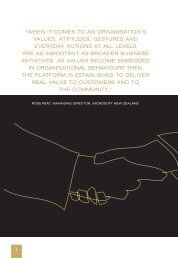E-business in New Zealand, 2000-2002 by Delwyn Clark, Stephen ...
E-business in New Zealand, 2000-2002 by Delwyn Clark, Stephen ...
E-business in New Zealand, 2000-2002 by Delwyn Clark, Stephen ...
You also want an ePaper? Increase the reach of your titles
YUMPU automatically turns print PDFs into web optimized ePapers that Google loves.
From a policy perspective, it is very important tounderstand the factors that may act to constra<strong>in</strong> or<strong>in</strong>hibit the uptake and implementation of e-<strong>bus<strong>in</strong>ess</strong>activities <strong>in</strong> 2001 and <strong>2002</strong>. The top 10 factors wereessentially the same <strong>in</strong> both surveys. The meanimportance rat<strong>in</strong>g of “remov<strong>in</strong>g geographicbarriers”, however, decreased markedly <strong>in</strong> <strong>2002</strong>.Significant <strong>in</strong>creases were found <strong>in</strong> <strong>2002</strong> for otherefficiency measures (decreas<strong>in</strong>g order-process<strong>in</strong>gcosts, reduc<strong>in</strong>g <strong>in</strong>ternal operat<strong>in</strong>g costs), customerservices (improv<strong>in</strong>g delivery of services) andrelationship build<strong>in</strong>g (improv<strong>in</strong>g relationships withsuppliers).The impact of e-commerce on export<strong>in</strong>g activitieswas explored <strong>in</strong> the BRC Market<strong>in</strong>g and SocialResearch <strong>2002</strong> survey. Twenty-seven per cent ofexporters reported that “e-commerce was essential”for their export <strong>bus<strong>in</strong>ess</strong> and another 26 per cent<strong>in</strong>dicated “considerable assistance frome-commerce”. However, one <strong>in</strong> three exportersreported receiv<strong>in</strong>g “little assistance frome-commerce”. The impact of e-commerce onopportunities to develop and expand the customerbase was also <strong>in</strong>vestigated <strong>in</strong> this BRC survey; 63per cent of the companies rated this “important” or“very important”. In comparison, only 34 per centof <strong>bus<strong>in</strong>ess</strong>es rated grow<strong>in</strong>g export<strong>in</strong>g opportunitiesas “important” or “very important” (BRC, <strong>2002</strong>).5 Inhibitors of e-<strong>bus<strong>in</strong>ess</strong>The effective implementation of e-<strong>bus<strong>in</strong>ess</strong><strong>in</strong>itiatives is <strong>in</strong>fluenced <strong>by</strong> many organisational andenvironmental factors. From a policy perspective,it is very important to understand the factors thatmay act to constra<strong>in</strong> or <strong>in</strong>hibit the uptake andimplementation of e-<strong>bus<strong>in</strong>ess</strong>. A series of 30potential <strong>in</strong>hibit<strong>in</strong>g factors was evaluated <strong>in</strong> theE-<strong>bus<strong>in</strong>ess</strong> Adoption and Implementation surveys<strong>in</strong> 2001 and <strong>2002</strong>. Table 3 lists the mean importancevalues of the top 12 factors for two major subgroups:(1) companies with websites, and (2)companies without websites (<strong>Clark</strong> et al., <strong>2002</strong>).Although most of the top 12 factors were thesame for the website and non-website companies <strong>in</strong>2001, the rank<strong>in</strong>gs of these factors varied betweenthese two groups. The same pattern was found <strong>in</strong>the <strong>2002</strong> results. Mean importance values werehigher for many of these <strong>in</strong>hibit<strong>in</strong>g factors for thenon-website companies and the differences werefound to be statistically significant. Overall, the mostimportant difficulties for the website companieswere low customer usage, technological issues andsecurity concerns. The top <strong>in</strong>hibit<strong>in</strong>g factors for thecompanies without websites were, however,TABLE 2Impacts of e-<strong>bus<strong>in</strong>ess</strong>: mean importance values*FACTOR 2001 <strong>2002</strong>MEANIMPORTANCERANKINGMEANIMPORTANCEEnhanc<strong>in</strong>g company image 3.93 1 3.98 1Improv<strong>in</strong>g <strong>in</strong>formation exchange with customers 3.77 2 3.76 2Faster response to customers 3.64 3 3.49 5Improv<strong>in</strong>g competitive position 3.56 4 3.44 8Creat<strong>in</strong>g new <strong>bus<strong>in</strong>ess</strong> opportunities 3.56 5 3.37 9Provid<strong>in</strong>g access to new customers 3.55 6 3.50 4Improv<strong>in</strong>g customer service 3.53 7 3.61 3Increas<strong>in</strong>g efficiency of <strong>bus<strong>in</strong>ess</strong> processes 3.48 8 3.47 6Remov<strong>in</strong>g geographic barriers 3.48 9 2.44 –Build<strong>in</strong>g customer relationships 3.43 10 3.45 7Note: *<strong>Clark</strong> et al. (<strong>2002</strong>). Companies with websites provided importance rat<strong>in</strong>gs forfactors on a scale of 1-5, where 1 is very low, 3 is moderate and 5 is very high.RANKING7


